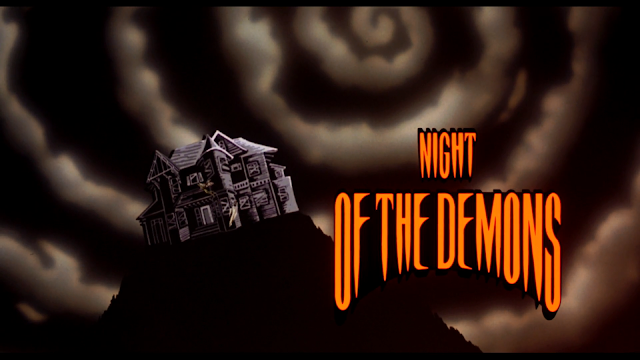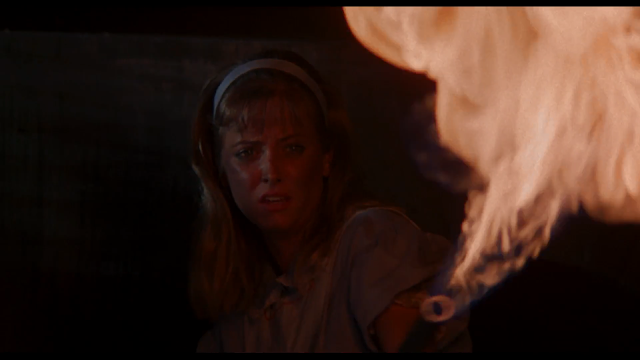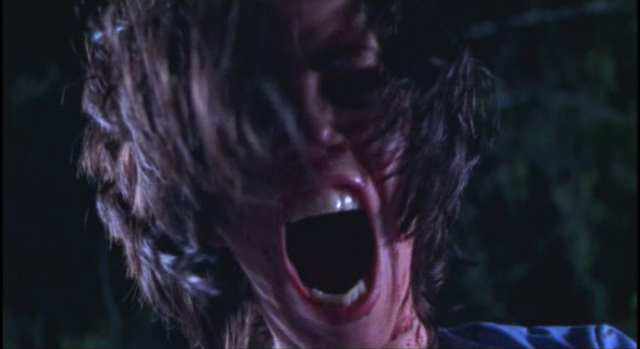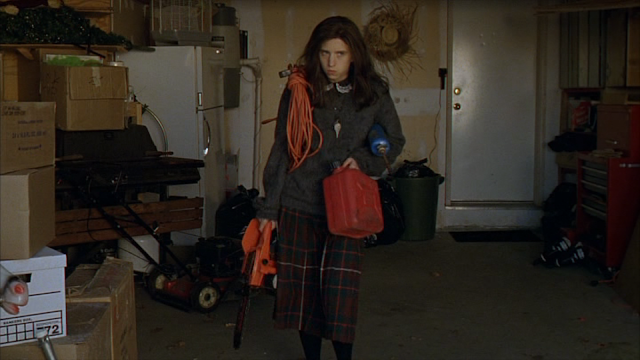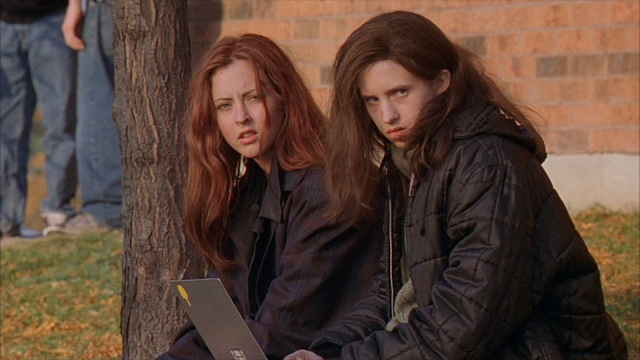Unfortunately, I got behind in my 31 Days of Halloween review-a-thon because I got called in for a job interview in Atlanta. I decided to go because I have always heard there are cities where seeing a sheriff's deputy swerving all over the road because he's trying to balance his police radio in one hand and a long-necked Corona in the other is not a common occurrence and I had to investigate that for myself.
Well, after driving all day through pouring rain and having my GPS cut out repeatedly while trying to find my hotel, I discovered a few things: 1) For a city with all of its amenities, Atlanta has absolutely nowhere to park, 2) Atlanta drivers are not hesitant about using their car horn at the slightest provocation and most disturbing of all, 3) valet parking proliferates. And gentle readers, I tell ya, there's nothing more I despise more then valet parking. The freedom a hard-working American experiences behind the wheel of their own car is the only privilege most of us have left. But some money grubbing greed swine wanna take that away too and have us pay for the supposed privilege of having a stranger park our car. What kind of Communist conspiracy is that?
Well, after all that, I get to the interview and find that the guy 1) has not read my resume, and 2) has no idea what job I'm applying for even though it was made clear by my cover letter.
"What are you doing now." he asked.
"I'm a writer," I said.
"So, you're unemployed," he sneered.
After having me tell him information that he could have simply read off my resume, he curtly informed me that he was looking for someone with 10 years experience.
I guess the joke's on him because he'll have a mighty hard time finding someone with 10 years experience wanting to work at a slumming personal injury firm for only $10 an hour and no benefits. Although maybe he can, because there ain't no place quite like the US of A where there is wealth and privilege abounds, but it remains in the hands of a select few while the rest of us are granted the liberty of being taxed to death and groveling for nickels. Hell, where's the French when you need 'em? I say it's guillotine time.
And speaking of class rage and reactionary violence, it's time for the ninth film in the 31 Days of Halloween marathon, the great CREEPSHOW (1982) directed by GEORGE ROMERO and written by everyone's favorite horror Everyman, STEPHEN KING. Some stuffed-shirt academic hambones will try to tell us Big Steve is a hack and that his books are the literary equivalent of a Big Mac, but I think these are the same kind of mush-heads who wrote off EDGAR ALLAN POE and H.P. LOVECRAFT back in the day. They're also the same people who write essays about Malamud and touch themselves and you don't wanna be in that crowd, trust me. For someone to successfully tap into the fears of such a wide variety of people - and to do it over and over again - there is something to them. STEPHEN KING doesn't just write horror, he writes about the average working man and working woman's everyday struggle in America. In addition to battling the forces of the supernatural, his characters also battle bills, family conflicts, their own personal demons, the narrow-minded cruelty and xenophobia of small town folks, and the painful realization that their place in the world is limited and their American Dream may never come true.
Besides, I think he can eat that wussy John Irving for lunch.
CREEPSHOW is an anthology film, which means it's a smorgasbord with something for everybody. In the wrap-around segment we're introduced to budding horror fan Billy (Steve's own son, JOE KING) whose Dad, despite being played by the awesome TOM ATKINS, is an uptight, overbearing douche. Seems he strongly disapproves of Billy filling his impressionable mind with the gruesome images in horror comics. "I've never seen such rotten crap in my life!" he bellows before slapping Billy and tossing his EC-style Creepshow comic book into the trash. From here, we're presented the five tales from the flapping pages of the comic book.
"Father's Day" is a story of revenge beyond the grave in which the domineering patriarch of a wealthy and avaricious clan is murdered by his long-suffering daughter only to return from the grave for his Father's Day cake. I know I'm not alone in my love for older actresses in horror films and like-minded individuals will be happy to know this segment boasts two knock-out performances by CARRIE NYE as the cold-blooded Sylvia and VIVECA LINDFORS as tortured, eccentric Jim Beam-swilling Aunt Bedelia. But despite this, and some impressive dance moves by a then-unknown ED HARRIS, I think this is the flimsiest of the five stories. Something about it always feel anti-climactic to me.
Bedelia is a fascinating character, though, and actually has a lot in common with the characterization of Lizzie in THE LEGEND OF LIZZIE BORDEN. She is a virtual prisoner of a cruel and tyrannical father; he has cast her in the role of his doting nursemaid rather than a daughter, but is never grateful for the sacrifices she has made for him. He continues to verbally abuse her and simply demands more and more. He even goes so far as to murder her beloved fiancée. Driven to madness, Bedelia bashes him over the head with a marble ashtray. Though her abuser is dead and she has inherited his lofty fortune, her guilt gnaws away at her. She cannot enjoy the life she has left and drowns her pain in alcohol. She allows her father to keep her a prisoner even beyond the grave.
Also, something that has always bothered me: why isn't ED HARRIS's character Hank the sole survivor of this segment? He's an in-law, so therefore has no part in the murder being avenged. And he's more of an average, if kind of stupid, nice guy unlike the spoiled siblings, Cass and Richard. Oh, well, I like Cass's white pants. But if she wore them after Labor Day, that in itself should be punishable by death.
In "The Lonesome Death of Jordy Verrill," KING himself plays the titular slow-witted country bumpkin who, in a comic version of LOVECRAFT's "The Colour of Outer Space," is overgrown by out of control weeds from a meteor that's landed on his farm.
A lot of people find this segment grating, but it's actually my second favorite as it's the cartooniest of the bunch. STEPHEN KING portrays the ill-fated Jordy with wide eyes, exaggerated jaw dropping and face-slapping like a live-action Wile E. Coyote. His fantasy sequences (in which BINGO O' MALLEY plays each character) are the silly icing on the ham cake. My favorite is his fantasy of a nightmarish doctor's visit, in which a crazed doctor (who, because the camera angle is canted, rolls in on said angle in his rolling chair) informs him his affected fingers will have to be cut off with a meat cleaver.
I think Jordy Verrill and I receive the same quality medical care.
But underneath all the goofiness, it's ultimately a pretty tragic story.
In "Something To Tide You Over," psychopathic billionaire Richard Vickers, played by comedy great LESLIE NIELSEN, discovers his much younger wife (DAWN OF THE DEAD's GAYLEN ROSS) has been having an affair with a pre-CHEERS TED DANSON. Tech wiz Richard engineers a sadistic revenge, burying the lovers up to their necks on separate ends of a private beach. They are videotaped and allowed to watch one another's prolonged drowning on a rigged monitor as the tide slowly rolls in. Unfortunately Richard doesn't realize he's in a horror movie and that his wife and her lover will rise for revenge as waterlogged zombies.
LESLIE NIELSEN really rocks this segment in an outstanding dramatic performance with dashes of dark humor. "The maiden fair is waiting for her knight in shining corduroy," he sing-songs as he entices TED DANSON to follow him onto the beach. Somehow the humor he injects into this character makes his psychopathic aspects more frightening; you get the impression he just really gets a kick out of torturing and murdering anyone who gets in his way. Mr. NIELSEN is rightfully renowned for his comedy acting, but he'd make a great Richard the III.
The zombie effects, while great in "Father's Day" as well, really excel here and are accompanied by a creepy, gurgling vocal effect.
Also, I have to wonder: how many other ex-wives and enemies does Richard have buried all over that beach?
The fourth is my favorite of the five segments; "The Crate" depicts the disintegrating marriage of meek college professor Henry Northrup (HAL HOLBROOK) and his boozy, big-mouthed abrasive wife, Wilma ('80s horror mainstay ADRIENNE BARBEAU). "Just call me Billie, everyone does," she shrills. Henry has repeated fantasies of killing her to put an end to her boozenanigans and bullying, but can't bring himself to divorce her. When a janitor uncovers a crate containing some kind of prehistoric monkey monster with a taste for human flesh, Henry sees a window of opportunity to end his miserable marriage once and for all.
Being a faculty brat myself, I love stories detailing the bitchiness of academia. Or academentia as those of us who have survived it call it. Seriously, I've met more warped personalities in academia than I have anywhere else and I've been on a psych ward. It's the horror equivalent of WHO'S AFRAID OF VIRGINIA WOOLF?, a play and movie that actually reminds me a lot of my parents before they divorced, except they weren't drunk so I don't know what their problem was.
And ADRIENNE BARBEAU as Billie makes being a boozy bitch look so damn great. The way she refers to Emily Post as "that etiquette crotch" at a faculty party, the way she pours liquor into a glass of milk, the way her smile quickly turns into a sneer as another driver honks at her, the way she barks, "Get out of my way, Henry, or I swear to God you're gonna be wearing your balls for earings!": I just love her so damn much. No, seriously I want Billie to be my new best friend and take me shopping. She knows all the best stores.
I don't think Billie was always such a shrew, though. She was probably one of those women that was taught to live through the success of her husband and was left disappointed when he didn't achieve what she perceived to be his potential. Female alcoholism in film is usually a manifestation of marital disappointment or feelings of being trapped without the same opportunities afforded to a man. I think Billie falls into this category. Spiteful about how her life has turned out, she turns on her husband. Henry too is the kind of person who has always done what other people wanted to do and is left miserable as a result. I also got the impression he may be a repressed homosexual with a serious man-crush on his colleague played by FRITZ WEAVER. Did anyone else get a major bromance vibe from their scenes together?
Academia is a notoriously back-stabbing and cutthroat environment so there's exhilarating seeing a crate monster rip it's way through faculty, students and staff.
The final segment is "They're Creeping Up on You," which was cut from the version I first saw on broadcast television. Character actor extraordinaire E.G. MARSHALL gives a great performance as paranoid, germ phobic billionaire corporate executive Upson Pratt. He lives as a recluse in a sterilized apartment listening to big band records, until a plague of cockroaches begin slowly infesting his sanctuary. Pratt's intense fear of roaches is symbolic of his disdain and fear of minorities and the lower classes. Perhaps it was having grown up in a tenement in Hell's Kitchen himself or the knowledge that he has acquired his wealth through ill-gotten means but in the end, his hatred consumes him (literally). MARSHALL really pulls out all the stops here and DAVID EARLY gives a brief, funny performance as the ironically named building super Mr. White.
This one really gets under my skin as years of living on the Gulf Coast has made me deathly afraid of cockroaches. Seriously, they're gross. And they have no purpose! What the hell do they do besides eat the glue in the lining of your books and look ugly as shit? Ugh, even talking about them is giving me the crawlies.
CREEPSHOW is a loving tribute to the E.C. Comics of the 1950s like Tales From the Crypt and The Haunt of Fear. I remember getting interested in them too (because of the 1990s HBO series) around the same time I first saw CREEPSHOW. And like the horror comics it pays homage to, CREEPSHOW is both subversive and conservative.
On one hand, both are subversive in that they relish in burning sacred cows. Both are allowed to push the envelope in their depictions of violence, the darkness and greed of the human heart, and rendering wholesome institutions entirely unwholesome because it's all in good fun.
Family is portrayed as a cannibalistic institution rather than one that provides nurture and protection. The innocent are cut down without a thought and the guilty that did it to them meet a retribution twice as ugly. People are not kind, god-fearing or hard-working: they're greedy, penurious and just plain mean as snakeshit. It's a grim view of the human race, but unfortunately an accurate one
On the other hand, transgressions are punished with an Old Testament-style wrath. The punishment doesn't just fit the crime, whatever has been done comes back ten fold. Karma is a bitch with rabies.
All of STEPHEN KING's writing is tinged with economic horror, and CREEPSHOW uses horror symbolism to explore financial anxieties and class rage in America.
The upper class in CREEPSHOW are all greedy, loathsome and have acquired their largesse by (both literally and figuratively) knocking someone else out of the way.
Nathan Grantham, the patriarch in "Father's Day" built has wealth upon bootlegging and murder. While Bedelia killed him out of vengeance for her murdered fiancée and to free herself from his abuse, her relatives were all too eager to swoop in and reap the benefits of patricide.
Richard Vickers does not love his wife so the murders he commits are not crimes of passion. His wife does not even want any of his money so his reasons are not financial, either. He simply murders two people because he cannot allow someone else to take something he considers to be his.
Horlicks University in "The Crate" is pervaded by passive-aggressive, back-stabbing departmental politics, job insecurity and repressed hostility, exemplified by the crated monster unleashed.
Upson Pratt's intense fear of cockroaches (which, like I said, stems from his fear of minorities and the lower classes) may come from his own feelings of inferiority for his working class background. Perhaps he fears their retribution because of the methods he has used to rise to the top above them. He has achieved the American Dream by becoming a self-made man, but he has done so at the expense of everyone else. In "They're Creeping Up On You," we learn that a merger he has initiated caused an opponent to commit suicide. When greeted with the news, Pratt exults, "Terrific!...Now we won't have to offer the old fart a seat on the board of directors!"
On the other hand, the poor work hard to keep the few privileges they have but are only fucked over in return.
Poor Jordy Verrill thinks $500.00 will make him a rich man ("Pay off that bank loan. That's the ticket!") and cannot cut a break to save his life. Under its jokey exterior and horror dressing, it's the tragic story of a man who has been overburdened to the point he has nothing left and takes his own life.
Economic insecurity has lead Henry and Wilma Northrup to become bitter, bickering and disillusioned and TED DANSON's character, Harry, works as a cook in a restaurant catering to tourists is essentially murdered by wealthy Richard for taking something that is not his.
Hank ends up being killed for his marriage into a higher class.
In CREEPSHOW, the American Dream is a pipe dream and the capitalist system is a cannibalistic one. You can never really get ahead, and in order to do so you need to cut off someone else's head.
But somehow viewing this all through the lens of a horror comic book makes it entertaining rather then depressing. GEORGE ROMERO and his trusty director of photography MICHAEL GORNICK replicate the visual style of a '50s comic book complete with panels, hyper-stylized colors, and gobos for emotional emphasis. The acting styles in the film are able to walk the fine line, real enough to be invested in the story but exaggerated enough to remind the viewer it's all for fun.
The lush score by JOHN HARRISON is one of my favorites. It's only a piano and a chorus but somehow manages to sound epic, both eerie and playful with the background vocals intoning "Nah nah nah nah" recalling childhood teasing.
I actually think CREEPSHOW might be even more of the ultimate Halloween movie than JOHN CARPENTER's HALLOWEEN.
The film's combination of playfulness and grisliness invoke the feeling I got as a kid with a burgeoning interest in horror. I think when I would try to catch a glimpse of the R-rated movies my parents were watching, CREEPSHOW is what I imagined they would be like.
With it's subtext of economic and social class anxieties, lovable irreverence and good ol' fashioned moral outrage, CREEPSHOW is all-American fun. Disliking it is just plain unpatriotic.










